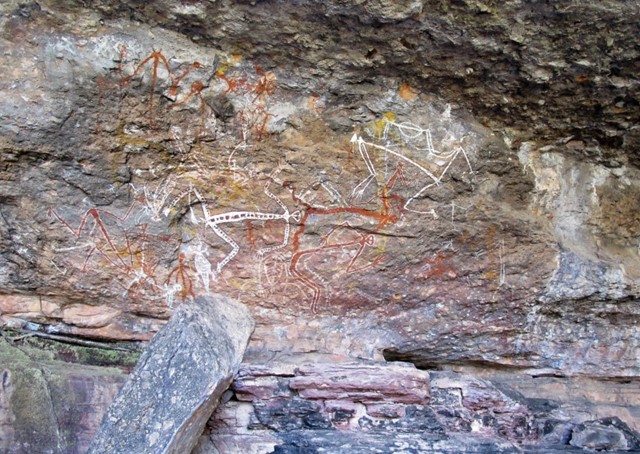The best way to understand and appreciate the ancient culture of this land is to engage with a local guide. Here, in Nourlangie, we gained a greater understanding of Aboriginal culture and to appreciate in a more informed way, the deep connection the First Peoples of this land have to it. Contrasted with other world ideas of ownership of the land and the drive to maximise its “value”, we saw that, to the Aboriginal people, the land is a living entity that could be said to own them. We saw their deep and abiding belief that they must respect, revere and protect it or it will suffer from neglect which will, in turn, have severe repercussions for them. As I listened and looked around I had visions of the destruction caused by mining in many parts of this continent.

Nourlangie, the anglicised version of “Nawurlandja” is the name given to the larger area while the lower areas are known as Anbangbang. The upper part of the rock is Burrungguy. The smoke in the photo above is from a naturally occurring fire near the Anbangbang shelter.

This area, with extensive woodlands, wetlands, creek and cliffs offering plenty of food opportunities, would, in ancient times, have been home to many people.. Artefacts and implements uncovered when layers of soil were excavated in the 1980s indicate that the caves were in use 20,000 to 60,000 years ago. Aboriginal people say that this area was used by the Warramal clan, traditional owners of the land and also by the Badmardi clan who came down from their higher areas to get food from the billabongs and woodland areas. The Warramal clan has died out so the Aboriginal owners from neighbouring areas have taken on the job of caring for this area. This was explained to us by our young, proud Aboriginal guide.

At Anbangbang, the rock paintings have several purposes. some tell cautionary stories which encourage the keeping of clan rules while others depict celebrations.

Nabulwinjbulwinj is a very fearsome spirit for women. He knocks them out with a yam and eats them. I couldn’t find out why it was that women were at risk or how they could avoid this fate. Whatever the reason, this must be one of the cautionary stories.

Namarrgon is a very important creation spirit who, even today, creates the violent thunder and lightning storms that bring the lifesaving rains. With his lightning band looping through his left ankle and through his head and hands down to his right ankle and with his thunder cracking axes on his elbows and feet, his appearance would be electrifying.
Lightning Man’s wife is Barrginj [Barr-jeen] and she is important because she is the mother of the Alyurr, the grasshoppers. Grasshoppers are important because in creation time they gave the Aboriginal people their language, beliefs and structure of their society. The Alyurr are amazingly beautiful blue and orange grasshoppers, rarely seen today, but appear just before the wet season when they call to their father, Lightning Man, to bring stormy relief to the people and the parched land.

There are many stories about the spirit ancestor, Namondjok. Our guide explained that Aboriginal laws dictate whom people may or may not marry. In Aboriginal law, one sister does not necessarily mean one’s sibling but includes first cousins on both sides of the family and some other less clear relationships. Namondjok broke the clan laws by marrying unlawfully and was punished by being turned into an estuarine crocodile. Other clans tell the story that Namondjok is an ancestor who lives in the sky and is seen only at night near the Milky Way.

After Namondjok married his sister, she took a feather from his headdress and placed it on the rocky outcrop to show others what they had done. She then became a rainbow serpent.

Anbangbang billabong is a kilometer or so from Nourlangie rock. The circular walk was closed because of crocodiles so we enjoyed lunch at one of the picnic tables. While sitting there peacefully I reflected on how resourceful and resilient the People had to be to live successfully in this beautiful but sometimes difficult environment.